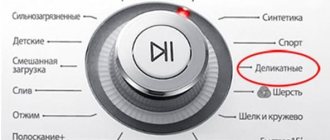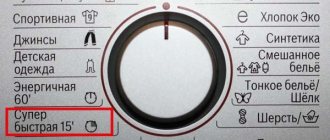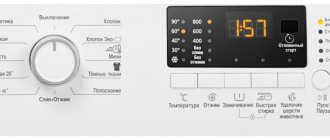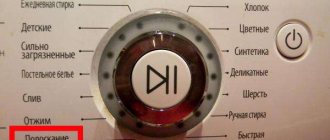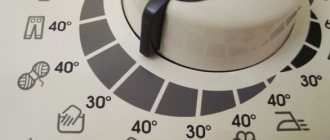What it is?
Probably everyone has things that require careful care. These include fabrics such as lace, silk, satin, chiffon, organza. But there is a risk of ruining clothes if you care for them incorrectly. Usually materials deteriorate when washed, for example, with an inappropriate cycle. But they require delicate washing. This keeps things beautiful for a long time.
Modern washing machines have different modes needed to work with different fabrics. Many have a “delicate wash”. This is gentle care for clothes. It is this that must be installed during each procedure.
On the control panel in washing machines, you can set modes depending on the fabric. There you can select the temperature, spin and other characteristics. To understand the principles of setup, just read the operating instructions for the equipment. A suitable mode will preserve the appearance of the material for a long time.
Useful tips for using washing machines
It is important to monitor the condition of your equipment, its integrity and serviceability. As a preventative measure, it is necessary to descale the heating elements once every three months. There is no need to disassemble or clean anything; only a master can do this. You just need to pour 60 grams into the powder compartment. citric acid and run the wash cycle at high temperature.
The use of voltage stabilizers will protect your machine from burnout and accidents, and the habit of leaving the door open after washing clothes will allow the machine to significantly increase its service life.
You might be interested in
- Designations on clothing labels: explanation
- How to clean a washing machine with citric acid
- Choosing a washing machine and dryer
Peculiarities
Delicate fabrics are washed according to the following standards:
- A lot of water is used, so the mechanical impact on the fabric structure is minimal.
- The water temperature is 30 degrees, the maximum it can be 40 degrees.
- This is fast mode. The more an item is washed, the higher the risk of deformation.
- The drum rotates smoothly and slowly.
- Spinning is performed at minimum speed - 400-700.
- Items are not dried or ironed, even if these functions are enabled by the manufacturers.
Handwash
Manual cleaning will help keep things in excellent condition for as long as possible. Which washing is better is a controversial issue, but every housewife is free to choose her own method. To ensure that your favorite things are not damaged during manual care, you must adhere to the basic rules:
- the water temperature should not exceed 25-30 degrees,
- Do not rub or twist the fabric too much,
- you need to slightly squeeze the item and release it so that it does not look wrinkled,
- the product must be allowed to drain into the basin,
- drying is carried out in a horizontal position so that the fabric does not stretch.
Expert opinion Kristina Samokhina Experienced housewife. Ask a question to an expert To clean such things, it is recommended to use a gel rather than a powder. Stains can be removed with a water-based stain remover.
What things need a routine?
A delicate washing cycle is necessary for natural and synthetic fabrics. It preserves the original appearance of silk, wool, guipure, satin, viscose, polyester, organza, lycra, elastane. These materials will not stretch or fade.
Delicate wash is a mode designed for brightly colored items and clothes with colored inserts. It should also be chosen for those products that have a lot of fittings or use several fabrics.
How is it designated?
The mode can be designated differently. There are manufacturers who indicate the category of fabric - cotton, synthetics, wool, as well as the optimal temperature. Symbols and pictograms are often used to indicate the presence of a mode.
If 30 degrees is indicated, then this is a “delicate wash”. The icon on the washing machine is presented in the form of an image of a bowl of water with a temperature designation and 1 or 2 horizontal lines on the bottom. Stripes indicate the use of large amounts of water.
In some devices, you can also find another designation on the panel - with the image of a hand, a feather, a flower, a silkworm butterfly or a skein of yarn. The last two pictures represent working with silk and wool.
Ironing
Recommendations for ironing products are intuitive; the iron symbol is used for this. Explanation of symbols:
- One point inside the iron - iron with a warm iron, temperature up to 110 degrees. This designation is displayed on silk and wool products, for many synthetic samples.
- Two points - medium mode, temperature up to 150 degrees.
- Three dots mean a hot iron (up to 200 degrees), such ironing is recommended only for dense natural items. The dots match the markings on the iron, so you don’t have to worry about temperature readings.
- Two vertical lines from the sole of the iron allow you to use the steam mode.
- Crossed out iron - the fabric cannot be ironed at all.
- Crossed lines under the soleplate indicate dry ironing; steam cannot be used.
Table 5. Icons showing how to iron the product
| Iron at the minimum temperature of the iron sole, without steam. |
| Iron at iron sole temperature up to 150⁰C. |
| Iron at maximum temperature with steam. |
| Do not iron. |
| Do not steam. |
Designations in different companies
All machines have a “delicate wash”, but manufacturers’ icons may differ. The equipment has modes for delicate items and hand washing. The two programs are similar. The first wash takes 30 minutes longer, but both are used to take care of things. According to the programs, the products are soaked.
There are similar functions in technology. The control panel has a hand wash symbol - a hand lowered into the basin. And the delicate mode is indicated in the form of a pen. The programs have the same effect as in the Ariston car.
The Bosch company designates women's dresses on typewriters. This is a delicate mode that can be used for delicate fabrics: silk, satin, mixed materials. Electrolux equipment has 3 programs necessary for working with delicate materials. Hand washing is indicated by a hand in a basin, and the “butterfly” symbol is for lightweight materials. The third function is intended for delicate products, it is presented in the form of a flower.
Zanussi machines have the most functions, there are 4 of them. Two of them are designed for hand washing, the difference is in the temperature - 30 and 40 degrees. The ability to select a program allows you to select the desired mode for careful care of things.
Whitening
A triangle is used to indicate bleaching. An empty geometric figure indicates that the product will not be damaged by bleaching agents. Usually these are natural white fabrics.
Additional icons for the triangle:
- Two oblique lines inside the figure warn against the use of chlorine. Only oxygen compounds. The crossed out triangle with the abbreviation “Cl” inside indicates the same thing.
- A triangle icon with the letters “Cl” without a diagonal cross - feel free to use a chlorine compound.
- You should not bleach a product if there is a crossed out triangle on the label. Use a gentle stain remover.
Table 5. Icons showing how to remove difficult stains from a product
| Bleaching allowed |
| Do not bleach |
| No chlorine |
Nuances
In order for delicate washing in a washing machine to be effective, you must follow a few simple rules:
- Colored items should be separated from light ones.
- For washing, it is advisable to use a special liquid detergent and a little softener.
- It is better to soak very dirty items in advance with stain remover.
- There are things, for example underwear, that need to be loaded into the machine only in special covers and bags.
- You should not leave clothes in the machine after finishing washing.
- Some products stretch, so they should not be hung and laid out to dry.
Setting the gentle mode
Some devices do not support delicate washing. There will be no icon on the washing machine. In this case, you need to learn how to configure it yourself:
- You should choose a short mode - about 40 minutes.
- The temperature should be 30-40 degrees.
- You can select double rinse.
- The spin speed should be adjusted. The maximum can be 800. But sometimes you should use drain without spin, this is usually indicated on the product tags.
- You need to disable drying and ironing if these functions are available.
Some modern Samsung branded machines have the Eco Bubble function. When washing, air bubbles appear, dissolving the granules of the washing substance. Therefore, even thin items remain intact, but are washed perfectly. This type of processing saves powder, water and energy.
Detergents
Using a delicate mode is not enough to preserve the appearance of the product. Washing powders are important. It is best to use liquid products. They dissolve well at low temperatures and are perfectly washed out of fabrics. They do not form pellets and the structure of the material is preserved.
Depending on the color of the item, bleaching powders and universal ones are used. The product must not contain phosphates or enzymes. Detergents with lanolin do an excellent job of removing stains. This substance has a mild effect on the material, preserving color.
Thus, the delicate mode has a gentle effect on the shape and color of clothes. The washing temperature is low and the duration of the procedure is minimal. Things do not deform and do not lose their original color. The mode saves effort and time. Things remain clean and beautiful.
Circle – dry cleaning
Circle (1) will tell you about the conditions of dry cleaning in specialized enterprises. There are pictures for regular “dry” cleaning.
- The crossed out circle (2) indicates that dry cleaning is prohibited.
- The letter A (3) indicates that treatment with any solvent is possible.
- The P icon in a circle (4) indicates that the procedure can be carried out with ethylene chloride, hydrocarbon, monofluorotrichloromethane.
- Underlined circle with the letter P (5) – the remedies from the previous version are valid, but the procedure itself is more gentle.
- Symbol F (6) allows the use of trifluorochloromethane and hydrocarbons.
- If the circle with F is underlined (7), then it is permissible to use the means described above, but in a delicate mode.
In addition to “dry” there is also “wet cleaning”. It has its own indicators, and the main one, which determines whether it is permissible to clean an object in this way, is a circle with the letter W (1):
- If the pictogram is crossed out (2), then water cleaning is impossible.
- When there is one horizontal line (3) under the symbol, you know that you need a delicate mode.
- A double underline (4) indicates the need for particularly careful procedure.
